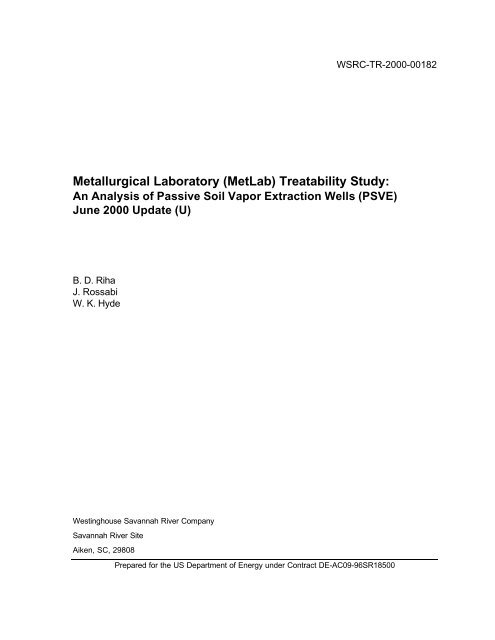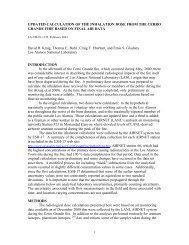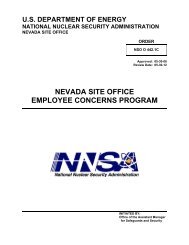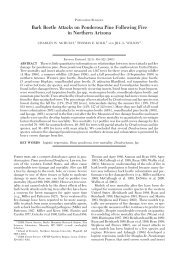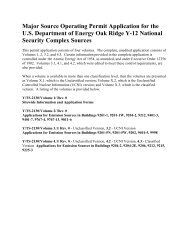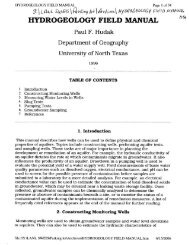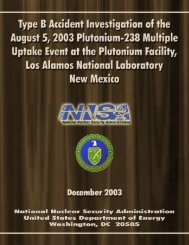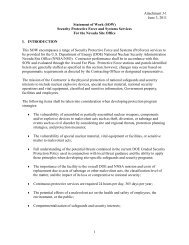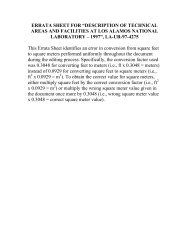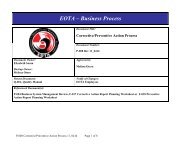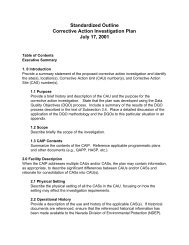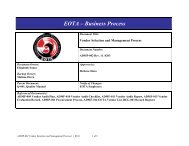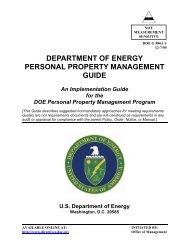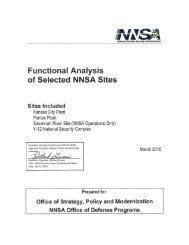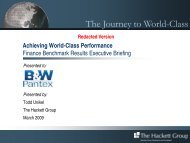An Analysis of Passive Soil Vapor Extraction Wells
An Analysis of Passive Soil Vapor Extraction Wells
An Analysis of Passive Soil Vapor Extraction Wells
You also want an ePaper? Increase the reach of your titles
YUMPU automatically turns print PDFs into web optimized ePapers that Google loves.
WSRC-TR-2000-00182<br />
Metallurgical Laboratory (MetLab) Treatability Study:<br />
<strong>An</strong> <strong>An</strong>alysis <strong>of</strong> <strong>Passive</strong> <strong>Soil</strong> <strong>Vapor</strong> <strong>Extraction</strong> <strong>Wells</strong> (PSVE)<br />
June 2000 Update (U)<br />
B. D. Riha<br />
J. Rossabi<br />
W. K. Hyde<br />
Westinghouse Savannah River Company<br />
Savannah River Site<br />
Aiken, SC, 29808<br />
Prepared for the US Department <strong>of</strong> Energy under Contract DE-AC09-96SR18500
This document was prepared in conjunction with work accomplished under Contract No.<br />
DE-AC09-96SR18500 with the U.S. Department <strong>of</strong> Energy.<br />
DISCLAIMER<br />
This report was prepared as an account <strong>of</strong> work sponsored by an agency <strong>of</strong> the United States Government.<br />
Neither the United States Government nor any agency there<strong>of</strong>, nor any <strong>of</strong> their employees, makes any<br />
warranty, express or implied, or assumes any legal liability or responsibility for the accuracy,<br />
completeness, or usefulness <strong>of</strong> any information, apparatus, product or process disclosed, or represents that<br />
its use would not infringe privately owned rights. Reference herein to any specific commercial product,<br />
process or service by trade name, trademark, manufacturer, or otherwise does not necessarily constitute or<br />
imply its endorsement, recommendation, or favoring by the United States Government or any agency<br />
there<strong>of</strong>. The views and opinions <strong>of</strong> authors expressed herein do not necessarily state or reflect those <strong>of</strong> the<br />
United States Government or any agency there<strong>of</strong>.<br />
This report has been reproduced directly from the best available copy.<br />
Available for sale to the public, in paper, from: U.S. Department <strong>of</strong> Commerce, National Technical<br />
Information Service, 5285 Port Royal Road, Springfield, VA 22161, phone: (800)<br />
553-6847, fax: (703) 605-6900, email: orders@ntis.fedworld.gov online ordering:<br />
http://www.ntis.gov/ordering.htm<br />
Available electronically at http://www.doe.gov/bridge<br />
Available for a processing fee to U.S. Department <strong>of</strong> Energy and its contractors, in paper, from: U.S.<br />
Department <strong>of</strong> Energy, Office <strong>of</strong> Scientific and Technical Information, P.O. Box 62, Oak Ridge, TN<br />
37831-0062, phone: (865 ) 576-8401, fax: (865) 576-5728, email: reports@adonis.osti.gov
Contents<br />
WSRC-TR-2000-00182<br />
MetLab Treatability Study: June 2000 Update<br />
EXECUTIVE SUMMARY...................................................................................................... 1<br />
BACKGROUND..................................................................................................................... 2<br />
SITE DESCRIPTION................................................................................................................. 2<br />
PREVIOUS CHARACTERIZATION EFFORTS ............................................................................ 2<br />
Geology............................................................................................................................. 2<br />
Original PSVE Well Installation....................................................................................... 3<br />
TECHNOLOGY DESCRIPTION - BAROMETRIC PUMPING........................................................ 4<br />
METHODS .............................................................................................................................. 6<br />
ADDITIONAL CHARACTERIZATION WORK IN FY00................................................................. 6<br />
WELL VAPOR SAMPLING AND ANALYSIS METHODS............................................................ 6<br />
RESULTS AND DISCUSSION ........................................................................................... 8<br />
FY00 CHARACTERIZATION RESULTS .................................................................................... 8<br />
WELL FLOW RATES AND VAPOR CONCENTRATION...........................................................10<br />
FLOW CONTROL ENHANCEMENT OF MASS REMOVAL......................................................19<br />
MASS REMOVAL ESTIMATION.............................................................................................19<br />
CONCLUSIONS...................................................................................................................22<br />
RECOMMENDATIONS.......................................................................................................23<br />
REFERENCES ....................................................................................................................23<br />
APPENDIX A - WELL VAPOR CONCENTRATIONS...................................................24<br />
APPENDIX B – CPT LOGS ...............................................................................................32<br />
APPENDIX C – WELL AND CPT BORING COORDINATES .....................................34<br />
iii
WSRC-TR-2000-00182<br />
MetLab Treatability Study: June 2000 Update<br />
List <strong>of</strong> Tables<br />
Table 1 – MLBB-022 <strong>Soil</strong> Gas Characterization Results................................................... 8<br />
Table 2 – MLBB-023 <strong>Soil</strong> Gas Characterization Results................................................... 9<br />
Table 3 – Trend Data Information and Average Freon-113 Concentrations for MetLab<br />
Vadose Zone Plume ......................................................................................................11<br />
Table 4 – Fitted PCE Concentration Data and Estimated Mass Removed by Well for<br />
the MetLab Vadose Zone Plume..................................................................................20<br />
Table 5 – Fitted TCE Concentration Data and Estimated Mass Removed by Well for<br />
the MetLab Vadose Zone Plume..................................................................................21<br />
List <strong>of</strong> Figures<br />
Figure 1 - MetLab Site Map................................................................................................... 3<br />
Figure 2 – CPT <strong>Soil</strong> Classification for MLBB-022 and MLBB-023................................... 9<br />
Figure 3 – PCE Well <strong>Vapor</strong> Concentration Trends for MetLab Vadose Zone Plume...11<br />
Figure 4 – TCE Well <strong>Vapor</strong> Concentration Trends for MetLab Vadose Zone Plume...12<br />
Figure 5 – TCE <strong>Soil</strong> Gas Plume Contours for MetLab Vadose Zone, ppmv (6/98 and<br />
1/99).................................................................................................................................13<br />
Figure 6 – TCE <strong>Soil</strong> Gas Plume Contours for MetLab Vadose Zone, ppmv (6/99 and<br />
1/00).................................................................................................................................14<br />
Figure 7 – TCE <strong>Soil</strong> Gas Plume Contours for MetLab Vadose Zone, ppmv (6/00)......15<br />
Figure 8 – PCE <strong>Soil</strong> Gas Plume Contours for MetLab Vadose Zone, ppmv (6/98 and<br />
1/99).................................................................................................................................16<br />
Figure 9 – PCE <strong>Soil</strong> Gas Plume Contours for MetLab Vadose Zone, ppmv (6/99 and<br />
1/00).................................................................................................................................17<br />
Figure 10 – PCE <strong>Soil</strong> Gas Plume Contours for MetLab Vadose Zone, ppmv (6/00) ...18<br />
Figure 11 – Cumulative Mass Removed for MetLab Vadose Zone Plume....................21<br />
iv
WSRC-TR-2000-00182<br />
MetLab Treatability Study: June 2000 Update<br />
Executive Summary<br />
The passive soil vapor extraction (PSVE) system at the MetLab <strong>of</strong> the Savannah River<br />
Site has been operating since May 1998. The results to date on the treatability study<br />
indicate the technology is performing well. Well concentrations are decreasing and<br />
contour maps <strong>of</strong> the vadose zone soil gas plume show a decrease in the extent <strong>of</strong> the<br />
plume. In the 2 years <strong>of</strong> operation approximately 270 pounds <strong>of</strong> chlorinated organic<br />
contaminants have been removed by natural barometric pumping <strong>of</strong> wells fitted with<br />
BaroBall valves (low pressure check valves).<br />
Additional characterization was completed in FY00 to evaluate the concentration <strong>of</strong> the<br />
soil gas plume on the south and west sides <strong>of</strong> the well field. One well was installed and<br />
two soil gas pushes were completed. The maximum soil gas concentrations observed<br />
from both CPT soil gas pushes were 3.0 ppmv PCE, 3.5 ppmv TCE, and 4.5 ppmv<br />
Freon 113. Additional wells were not installed due to the low concentrations. Based on<br />
the new characterization data and the monitoring results from the existing wells, the<br />
current well system adequately bounds the soil gas plume.<br />
At the current fitted removal rates all but 5 <strong>of</strong> the wells will be below 5 ppmv by the end<br />
<strong>of</strong> 2001. Projecting the concentration trends, all the wells will be below 5 ppmv by<br />
1/2005. The initial source mass estimate is 170 lbs TCE and 250 lbs PCE. These<br />
masses correspond to approximately 14 gallons <strong>of</strong> TCE and 18 gallons <strong>of</strong> PCE that will<br />
be removed from the subsurface at the site.<br />
Mass removal during this time frame is primarily attributed to residual contamination in<br />
the coarse grained material and contaminant mass transfer from the finer grained<br />
zones to coarse zones where the majority <strong>of</strong> the PSVE flow is achieved. Removal from<br />
the fine grained sediments will be limited by the mass transfer from these zones to the<br />
coarse grained zones.<br />
The PSVE system has required minimal operating and maintenance costs and can be<br />
expected to operate continuously for the life span <strong>of</strong> the remediation with little or no<br />
intervention. All <strong>of</strong> the vadose zone extraction wells installed can also be used with an<br />
active vapor extraction system.<br />
The PSVE system is performing well in a cost-effective manner. It is recommended that<br />
this system be allowed to continue operating to complete the remediation and to<br />
continue monitoring activities to verify and monitor the anticipated contaminant removal<br />
rates. The treatability study should be considered successfully completed and the<br />
remediation should be considered in full operation.<br />
1
WSRC-TR-2000-00182<br />
MetLab Treatability Study: June 2000 Update<br />
Background<br />
Site Description<br />
The Metallurgical Laboratory (MetLab) waste unit is located in the A/M areas <strong>of</strong> the<br />
SRS. During the 1950's to the early 1980's, solvents were used in MetLab facilities to<br />
degrease fuel and target tubes prior to use in other facilities at SRS. The solvents used<br />
during this period were primarily trichloroethylene (TCE) and tetrachloroethylene (PCE).<br />
Building 717-A is at the center <strong>of</strong> the soil gas plume and currently houses a machine<br />
shop.<br />
Previous Characterization Efforts<br />
The MetLab characterization was initiated to determine the vertical and lateral extent <strong>of</strong><br />
contaminants in the vadose zone to aid in determining the source <strong>of</strong> ground water<br />
contamination in the area. MetLab Phase I consisted <strong>of</strong> installation <strong>of</strong> seven<br />
groundwater monitoring wells and completion <strong>of</strong> one soil boring near the MetLab<br />
Hazardous Waste Management Facility (HWMF). TCE and PCE sediment<br />
concentrations in the vadose zone ranged from below detection (
WSRC-TR-2000-00182<br />
MetLab Treatability Study: June 2000 Update<br />
60 and 80 ft layers are interbedded and range in thickness from approximately 1 to 15<br />
ft. The water table at the site is approximately 140 ft below the ground surface.<br />
Original PSVE Well Installation<br />
Nineteen vadose zone wells were installed at the MetLab using direct push with a Cone<br />
Penetrometer Testing (CPT) truck after the Phase III characterization. The wells were<br />
installed by threading a steel push tip onto the PVC screen and pushing the tip with the<br />
steel CPT rods in the center <strong>of</strong> the PVC, effectively pulling the PVC well down with the<br />
push tip. The CPT rods are removed and the 6 inch long steel push tip and well remain<br />
in the ground.<br />
The wells were installed so the formation was compressed against the outer surface <strong>of</strong><br />
the casing and screen, leaving no annular space. This seal is verified by sustained gas<br />
pressure differences between the surface and subsurface. The wells were installed with<br />
continuous screens from 20 to 80 feet below surface. Concrete pads were installed<br />
around the wells at the surface.<br />
905-53A<br />
711-A<br />
729-A<br />
734-A<br />
N<br />
MLBB-004<br />
717-12A<br />
MLBB-013<br />
MLBB-020<br />
MLBB-003<br />
MLBB-014<br />
717-A<br />
717-7A<br />
MLBB-021<br />
MLBB-001<br />
MLBB-002<br />
723-7A<br />
MLBB-006<br />
MLBB-008 MLBB-010<br />
MLBB-007<br />
MLBB-009<br />
MLBB-015<br />
MLBB-012<br />
MLBB-011<br />
717-3A<br />
MLBB-016<br />
MLBB-019<br />
712-A<br />
MLBB-022<br />
722-2A<br />
723-13A<br />
MLBB-023<br />
722-A<br />
722-4A<br />
MLBB-017<br />
723-A<br />
722-1A<br />
722-8A<br />
MLBB-018<br />
PSVE <strong>Wells</strong><br />
CPT characterization push<br />
Not a well<br />
Figure 1 - MetLab Site Map<br />
3
Technology Description - Barometric Pumping<br />
WSRC-TR-2000-00182<br />
MetLab Treatability Study: June 2000 Update<br />
Natural atmospheric pressure fluctuations are transmitted through the unsaturated<br />
subsurface, however, these pressure waves are damped and delayed in phase to<br />
degrees dependent on the effective vertical permeability <strong>of</strong> the formation. As a result <strong>of</strong><br />
the attenuation and delay <strong>of</strong> the transmitted pressure wave, at a given time the<br />
atmospheric pressure at the surface and the soil gas pressure in the subsurface will be<br />
different. If these two zones are directly connected (by a vadose zone well), the<br />
pressure differential will result in a flow either into or out <strong>of</strong> the well. If the subsurface<br />
contains VOCs in the gas phase, flow out <strong>of</strong> the well will result in removal <strong>of</strong> the<br />
contaminants from the subsurface without mechanical pumping. This phenomena has<br />
been observed for more than a century, (the first reference in the literature is an article<br />
in Science, 1897 by Fairbanks) but has only recently been proposed for environmental<br />
remediation. The technology is also known as barometric pumping. The duration <strong>of</strong> flow<br />
events (either flow into the well or flow out <strong>of</strong> the well) can be as long as three days<br />
continuously but, as expected by mass balance considerations, the average time <strong>of</strong><br />
flow in is equal to the average time <strong>of</strong> flow out. The flow rates for a typical well are<br />
generally low (1 to 10 scfm) but if the concentration <strong>of</strong> the contaminant in the gas phase<br />
is high, mass removal by this process can be significant. Rates as high as 1 to 2<br />
kg/day/well have been observed near sources in the A/M Area <strong>of</strong> SRS. Mass removal<br />
can be enhanced using low cost or natural techniques. Enhancements to PSVE include<br />
the addition <strong>of</strong> wind powered turbine vacuum pumps, installation <strong>of</strong> one way mechanical<br />
valves to prevent dilution <strong>of</strong> the contaminated soil gas by clean air from the surface, and<br />
solar heat injection to raise vapor pressures and the partitioning <strong>of</strong> the VOCs from the<br />
liquid or aqueous phases to the gas phase.<br />
The BaroBall is a device developed and patented by WSRC specifically for barometric<br />
pumping applications. It uses a lightweight ball in a conical seat to permit gas flow in<br />
one direction with a minimal pressure requirement (approximately 1 millibar) but<br />
effectively prevents gas flow in the reverse direction. Depending on the configuration,<br />
the BaroBall can be used to allow contaminated soil gas out <strong>of</strong> a well and prevent clean<br />
air from diluting the soil gas in the subsurface (standard mode <strong>of</strong> operation), to inject air<br />
and/or nutrients into the subsurface to enhance bioremediation, to control or confine the<br />
movement <strong>of</strong> a subsurface gas phase plume in the vadose zone, or to passively<br />
transfer solar heated, water-saturated air into the subsurface to enhance volatilization in<br />
the subsurface. The BaroBall device is attached directly to the top <strong>of</strong> the well casing at<br />
the surface.<br />
Application <strong>of</strong> this technology is directed to any site where volatile substances<br />
(chlorinated solvents, petroleum products, etc.) have contaminated the vadose zone.<br />
Natural pressure fluctuations and their damped and delayed transmission through the<br />
subsurface occur in all environments but are particularly well-suited to sites with large<br />
vadose zones or substantial low permeability layers that increase the damping and<br />
delay <strong>of</strong> the atmospheric pressure signal.<br />
4
WSRC-TR-2000-00182<br />
MetLab Treatability Study: June 2000 Update<br />
Field scale studies have been ongoing at SRS, the Hanford site and the Idaho National<br />
Environmental Engineering Lab for approximately six years, and a field scale<br />
implementation <strong>of</strong> the technology for control <strong>of</strong> subsurface methane migration using a<br />
combination <strong>of</strong> passive injection and extraction was installed at a landfill in Richmond<br />
County, Georgia. In addition several other contaminated sites, both public and private,<br />
have implemented barometric pumping remediation programs with the BaroBall. The<br />
1996 start <strong>of</strong> PSVE at the SRS Miscellaneous Chemical Basin was the first<br />
implementation to directly target the removal <strong>of</strong> the vadose zone source term.<br />
5
WSRC-TR-2000-00182<br />
MetLab Treatability Study: June 2000 Update<br />
Methods<br />
Additional Characterization Work in FY00<br />
Additional characterization was completed in FY00 to evaluate the concentration <strong>of</strong> the<br />
soil gas plume on the south and west sides <strong>of</strong> the well field.<br />
One PSVE well (MLBB-021) was installed to the west <strong>of</strong> Building 717-A as a<br />
technology demonstration and to characterize and bound the western side <strong>of</strong> the plume.<br />
The well was installed using a Geoprobe with 3 inch casing and the well was completed<br />
with sand pack with a bentonite seal. The well provides a significant amount <strong>of</strong> flow. The<br />
well was installed to depth <strong>of</strong> 52 ft with a screen zone from 30 to 50 ft and a 2 ft sump.<br />
This was the first time a well has been installed in this manner at SRS. The success <strong>of</strong><br />
this new technology deployment provides an additional tool for lower cost shallow and<br />
vadose zone well installations without generation <strong>of</strong> investigative derived waste (IDW).<br />
The Geoprobe and operators were provided by Miller Drilling Company as a<br />
demonstration <strong>of</strong> their capabilities.<br />
Two soil gas characterization pushes were completed to depths <strong>of</strong> approximately 100 ft<br />
with the DOE Subsurface Characterization and Penetration System (SCAPS) truck<br />
using the standard CPT and the Conesipper soil gas and water sampling tool. One<br />
push was done to the north <strong>of</strong> Building 723-A and the other push was done east <strong>of</strong><br />
Building 722-A. The soil gas was analyzed using an Innova Model 1312 Multi Gas<br />
<strong>An</strong>alyzer with confirmatory gas chromatography analysis on several samples.<br />
One soil gas push was completed using the new CPT Wire Line Tool near 722-A. This<br />
new tool is a recently developed wireline CPT system that allows various tools to be<br />
placed at the tip <strong>of</strong> the rod string depending on the type <strong>of</strong> information or sample<br />
desired while the rod remains in the ground. The wireline piezocone tool has been<br />
validated statistically against American Society <strong>of</strong> Testing and Materials (ASTM)<br />
standard cones and the depth capability <strong>of</strong> the system was found to compare favorably<br />
with that <strong>of</strong> conventional CPT. The Wire Line Piezo Cone was withdrawn from the rods<br />
leaving the rods open at the bottom and soil gas was pumped directly through the rods.<br />
Flow rates <strong>of</strong> 1.5 cfm were observed (maximum capacity <strong>of</strong> the pump) with the Wire<br />
Line sampling method that resulted in a radius <strong>of</strong> capture <strong>of</strong> approximately 4 ft in 10<br />
minutes. Usual flow rates with the CPT and Consipper are 0.1 cfm. This new method<br />
for soil gas sampling decreases the time to purge the lines and pull a sample and<br />
dramatically increases the radius <strong>of</strong> capture for soil gas sampling. The CPT Wireline<br />
<strong>Soil</strong> Sampler was developed by Applied Research Associates (ARA, Inc.) with funding<br />
from the Department <strong>of</strong> Energy's National Energy Technology Laboratory (NETL).<br />
Well <strong>Vapor</strong> Sampling and <strong>An</strong>alysis Methods<br />
Concentration measurements were made on the vadose zone wells during barometric<br />
pumping outflow events. Well vapor was sampled and analyzed using a Innova Model<br />
6
WSRC-TR-2000-00182<br />
MetLab Treatability Study: June 2000 Update<br />
1312 photo-acoustic infrared gas analyzer (new model <strong>of</strong> the Bruel and Kjaer Model<br />
1302). The instrument was calibrated to measure TCE, PCE, Freon 113 and CO 2 . The<br />
Freon-113 interference problems on the instrument were corrected in January 2000<br />
and a reliable measurement is now possible with the infrared instrument. The correction<br />
was done by installing an additional band pass optical filter in the instrument to<br />
measure Freon-113 and to compensate for interference <strong>of</strong> the Freon-113 on the optical<br />
filters used to measure TCE and PCE. Samples were also obtained in Tedlar sample<br />
bags and analyzed on an HP 5890 series gas chromatograph (GC) to verify the<br />
reliability <strong>of</strong> the infrared instrument.<br />
7
WSRC-TR-2000-00182<br />
MetLab Treatability Study: June 2000 Update<br />
Results and Discussion<br />
FY00 Characterization Results<br />
Additional characterization was completed in FY00 to evaluate the concentration <strong>of</strong> the<br />
soil gas plume on the south and west sides <strong>of</strong> the well field. The purpose <strong>of</strong> the<br />
characterization was to estimate the boundary <strong>of</strong> the plume and determine if additional<br />
wells were needed to effectively remediate the area. CPT push MLBB-022 was also<br />
used to revisit a higher concentration measurement encountered during the Phase I<br />
characterization in 1995. The higher concentration was not encountered. The locations<br />
<strong>of</strong> these pushes are shown in Figure 1. The maximum soil gas concentrations observed<br />
from both CPT soil gas pushes were 3.0 ppmv PCE, 3.5 ppmv TCE, and 4.5 ppmv<br />
Freon 113. The analysis results are provided in Tables 1 and 2. The CPT friction ratio<br />
and soil classification for each push is provided in Figure 2. The friction ratio is a<br />
general measure <strong>of</strong> soil types where higher friction ratios indicate finer grained<br />
material. Additional wells were not installed due to the low concentrations. New PSVE<br />
wells at these locations would not generate significant mass removal and the existing<br />
wells are adequately addressing the soil gas plume on the south side.<br />
One PSVE well (MLBB-021) was installed to the west <strong>of</strong> Building 717-A as a<br />
technology demonstration and to characterize and bound the western side <strong>of</strong> the plume.<br />
The well is screened from 20 to 50 ft. The target depth <strong>of</strong> 80 ft was not reached due to<br />
an equipment failure. When the equipment is functioning, it appeared the depth would<br />
be achievable. The well provides a significant amount <strong>of</strong> flow and provides a good<br />
boundary measurement for the soil gas plume. Based on the new characterization data<br />
and the monitoring results from the existing wells, the current well system adequately<br />
bounds the soil gas plume.<br />
Table 1 – MLBB-022 <strong>Soil</strong> Gas Characterization Results<br />
Infrared <strong>An</strong>alyzer Results<br />
(ppmv)<br />
GC Results<br />
(ppmv)<br />
Depth Freon<br />
Freon<br />
(ft) 113 PCE TCE CO2 113 PCE TCE<br />
20 1.37 0.42 0.21 12300<br />
29 1.59 1.25 0.69 16100<br />
36 2.11 1.23 0.85 15000<br />
46 2.73 1.41 1.12 17300<br />
70 4.04 1.27 1.82 17000 4.54 0.64 1.22<br />
90 0.00 0.97 0.96 8700<br />
102 0.00 0.91 0.99 9010<br />
107 0.85 0.00 0.05 5320<br />
8
WSRC-TR-2000-00182<br />
MetLab Treatability Study: June 2000 Update<br />
Table 2 – MLBB-023 <strong>Soil</strong> Gas Characterization Results<br />
Infrared <strong>An</strong>alyzer Results<br />
(ppmv)<br />
GC Results<br />
(ppmv)<br />
Depth Freon<br />
Freon<br />
11 CFC<br />
ft 113 PCE TCE CO2 113 PCE TCE DCE CCl4 11 TCA<br />
14 0.23 0.00 0.16 6680<br />
25 0.00 0.47 0.98 6610<br />
35 0.00 0.41 0.48 3190<br />
46 0.00 0.48 0.76 5290<br />
58 0.00 0.95 1.79 6730 0.09 0.63 1.55 Nd nd nd nd<br />
68 0.00 1.39 1.96 10500<br />
78 0.00 1.38 2.05 8470<br />
88 1.56 3.00 3.45 13000 2.32 1.67 2.85 0.14 0.02 0.21 0.04<br />
95 0.64 2.33 2.57 11100<br />
Ratio COR<br />
(%)<br />
Ratio COR<br />
(%)<br />
0 10<br />
0 0<br />
Sand<br />
OC<br />
OC - Clay<br />
OC<br />
OC Sand - Clay<br />
Sand<br />
OC - Clay<br />
20 20<br />
0 10<br />
0 0<br />
SandMix<br />
Sand OC<br />
OC - Clay<br />
Sand<br />
20 20<br />
Sand Mix<br />
Depth (ft)<br />
Sand Mix<br />
Sand<br />
40 40<br />
Sand Mix<br />
Sand Mix<br />
Cl Clay Silt<br />
Clay<br />
Cl Silt<br />
Sand Mix<br />
60 60<br />
Clay<br />
Sand Mix<br />
Depth (ft)<br />
Sand<br />
Sand Mix<br />
Sand SandMix<br />
Sand<br />
Sand Mix<br />
Sand<br />
40 40<br />
Sand Mix<br />
Clay<br />
Sand Mix<br />
Clay<br />
60 60<br />
Clay<br />
Sand Mix<br />
Sand Mix<br />
80 80<br />
80 80<br />
Cl Silt<br />
Clay<br />
Cl Silt<br />
Sand Mix<br />
Sand<br />
Sand Mix<br />
Cl Sand Silt<br />
100 100<br />
Clay<br />
Sand Mix<br />
Cl Silt<br />
Sand Mix<br />
Sand<br />
100 100<br />
MLBB-022<br />
MLBB-023<br />
Figure 2 – CPT <strong>Soil</strong> Classification for MLBB-022 and MLBB-023<br />
9
Well Flow Rates and <strong>Vapor</strong> Concentration<br />
WSRC-TR-2000-00182<br />
MetLab Treatability Study: June 2000 Update<br />
Well vapor concentration measurements show mass removal and a concentration<br />
decrease in the vadose zone at the MetLab. Wellhead measurements were made<br />
during outflow events with an infrared photo-acoustic analyzer calibrated for PCE, TCE,<br />
Freon-113 and CO 2 . The contaminant concentrations were normalized with the CO 2<br />
concentrations to the average soil gas CO 2 levels <strong>of</strong> each well. This normalization<br />
provides a more realistic representation <strong>of</strong> soil gas concentration in the subsurface by<br />
correcting for surface air dilution. The Baroballs leak slightly during inflow periods which<br />
dilutes the soil gas and produces low readings during the beginning <strong>of</strong> outflow events.<br />
Monitoring <strong>of</strong> sealed vadose zone wells have shown CO 2 concentrations are fairly<br />
constant in the subsurface. However, varying concentrations <strong>of</strong> CO 2 have been<br />
observed to correlate to the TCE and PCE concentrations in individual wells at the<br />
Miscellaneous Chemical Basin after four years <strong>of</strong> monitoring. This is attributed to<br />
infiltrating surface air diluting the soil gas concentration <strong>of</strong> both CO 2 and the<br />
contaminants in a particular well. The normalized concentration values are provided in<br />
Appendix A. Both the Innova and the GC values are provided but only the GC values<br />
were used for calculations up to January 2000. The Innova data was used for<br />
calculations starting in January 2000.<br />
<strong>Soil</strong> gas concentrations measured over this 2 year time period show an exponentially<br />
declining concentration as is expected based on a conceptual model <strong>of</strong> mass transfer<br />
from the liquid or aqueous phase in the fine grain zones to the gas phase in the coarse<br />
grain sediments. The early data is limited and most data points used for the exponential<br />
fits do not cover the entire 2 year period. The date range and number <strong>of</strong> data points<br />
used for each fit is provided in Table 3 along with the average Freon 113<br />
concentrations. The data is provided in Appendix A.<br />
The concentrations were projected back to the start <strong>of</strong> the PSVE (May 1998) to<br />
estimate size and concentration <strong>of</strong> the soil gas plume and mass removal. <strong>An</strong> average<br />
concentration was used for the lower concentration wells due to the variability <strong>of</strong> the<br />
analysis instrument at the low concentrations. The parameters for the exponential<br />
concentration decline equations are provided in Table 4 and 5. Selected concentration<br />
trends along with the correlation coefficient (quality <strong>of</strong> fit) from several wells are shown<br />
in Figure 3 and 4.<br />
10
WSRC-TR-2000-00182<br />
MetLab Treatability Study: June 2000 Update<br />
Table 3 – Trend Data Information and Average Freon-113 Concentrations for MetLab<br />
Vadose Zone Plume<br />
Number <strong>of</strong> Data Points<br />
used for Trends or<br />
Average Values<br />
Average<br />
Freon<br />
113, ppmv<br />
Well ID<br />
Date Range<br />
MLBB-001 10 10/14/97-3/27/00 0.50<br />
MLBB-002 7 12/29/98-3/27/00 0.79<br />
MLBB-003 9 * 12/29/98-3/27/00 0.24<br />
MLBB-004 8 12/29/98-3/27/00 1.12<br />
MLBB-006 7 11/24/98-3/27/00 0.70<br />
MLBB-007 7 12/29/98-3/27/00 2.04<br />
MLBB-008 12 5/8/98-3/27/00 0.91<br />
MLBB-009 9 12/29/98-3/27/00 2.75<br />
MLBB-010 10 11/24/98-3/27/00 1.08<br />
MLBB-011 9 12/29/98-3/27/00 3.07<br />
MLBB-012 9 12/16/98-3/27/00 0.76<br />
MLBB-013 9 * 12/29/98-3/27/00 0.76<br />
MLBB-014 8 * 12/29/98-3/27/00 0.58<br />
MLBB-015 9 12/16/98-3/27/00 1.45<br />
MLBB-016 9 * 12/29/98-3/27/00 3.71<br />
MLBB-017 8 * 12/29/98-3/27/00 3.79<br />
MLBB-018 9 * 12/29/98-3/27/00 3.70<br />
MLBB-019 9 * 3/25/99-3/27/00 0.89<br />
MLBB-020 8 * 5/24/99-3/27/00 0.65<br />
* Measurement results were averaged for one or both compounds<br />
120<br />
PCE Concentration, ppmv<br />
80<br />
40<br />
MLBB-009<br />
R 2 = 0.90<br />
MLBB-001<br />
R 2 = 0.78<br />
MLBB-008<br />
R 2 = 0.68<br />
MLBB-002<br />
R 2 = 0.57<br />
0<br />
MLBB-004<br />
R 2 = 0.60<br />
Jun-97 Jan-98 Jul-98 Feb-99 Aug-99 Mar-00 Oct-00<br />
Figure 3 – PCE Well <strong>Vapor</strong> Concentration Trends for MetLab Vadose Zone Plume<br />
11
WSRC-TR-2000-00182<br />
MetLab Treatability Study: June 2000 Update<br />
80<br />
60<br />
TCE Concentration, ppmv<br />
40<br />
MLBB-001<br />
R 2 = 0.58<br />
MLBB-008<br />
R 2 = 0.77<br />
20<br />
MLBB-009<br />
R 2 = 0.86<br />
0<br />
Jun-97 Jan-98 Jul-98 Feb-99 Aug-99 Mar-00 Oct-00<br />
Figure 4 – TCE Well <strong>Vapor</strong> Concentration Trends for MetLab Vadose Zone Plume<br />
Concentration contour plots <strong>of</strong> TCE and PCE well concentrations at 6/98, 1/99, 6/99,<br />
1/00 and projected to 6/00 are provided in Figures 5 through 10. The wells have long<br />
screens (60 ft) so these plots show a general representation <strong>of</strong> the soil gas plume at the<br />
unit. Over the 2 years <strong>of</strong> PSVE with Baroball flow enhancement, the soil gas plume has<br />
decreased in concentration and size. The contours were created using the fitted<br />
exponential equations. These contour plots show the PSVE is decreasing the size and<br />
mass <strong>of</strong> the plume and is adequately covering the soil gas plume.<br />
12
WSRC-TR-2000-00182<br />
MetLab Treatability Study: June 2000 Update<br />
TCE 6/98<br />
TCE 1/99<br />
905-53A<br />
711-A<br />
7 2 9 -A<br />
734-A<br />
905-53A<br />
711-A<br />
7 2 9 -A<br />
734-A<br />
MLBB-004<br />
717-12A<br />
MLBB-013<br />
MLBB-020<br />
MLBB-004<br />
717-12A<br />
MLBB-013<br />
MLBB-020<br />
MLBB-003<br />
MLBB-014<br />
MLBB-003<br />
MLBB-014<br />
717-A<br />
717-7A<br />
717-A<br />
717-7A<br />
MLBB-021<br />
MLBB-021<br />
MLBB-001<br />
MLBB-006<br />
MLBB-008<br />
MLBB-010<br />
MLBB-015<br />
MLBB-012<br />
MLBB-019<br />
712-A<br />
MLBB-001<br />
MLBB-006<br />
MLBB-008<br />
MLBB-010<br />
MLBB-015<br />
MLBB-012<br />
MLBB-019<br />
712-A<br />
MLBB-011<br />
MLBB-011<br />
MLBB-002<br />
723-7A<br />
MLBB-007<br />
MLBB-009<br />
717-3A<br />
MLBB-016<br />
MLBB-002<br />
723-7A<br />
MLBB-007<br />
MLBB-009<br />
717-3A<br />
MLBB-016<br />
722-2A<br />
723-13A<br />
722-2A<br />
723-13A<br />
722-A<br />
MLBB-023<br />
(Not a Well)<br />
7 2 2 -4 A<br />
MLBB-017<br />
723-A<br />
722-A<br />
MLBB-023<br />
(Not a Well)<br />
7 2 2 -4 A<br />
MLBB-017<br />
723-A<br />
722-1A<br />
722-1A<br />
722-8A<br />
MLBB-018<br />
722-8A<br />
MLBB-018<br />
Figure 5 – TCE <strong>Soil</strong> Gas Plume Contours for MetLab Vadose Zone, ppmv (6/98 and 1/99)<br />
13
WSRC-TR-2000-00182<br />
MetLab Treatability Study: June 2000 Update<br />
TCE 6/99<br />
TCE 1/00<br />
905-53A<br />
711-A<br />
7 2 9 -A<br />
734-A<br />
905-53A<br />
711-A<br />
7 2 9 -A<br />
734-A<br />
MLBB-004<br />
717-12A<br />
MLBB-013<br />
MLBB-020<br />
MLBB-004<br />
717-12A<br />
MLBB-013<br />
MLBB-020<br />
MLBB-003<br />
MLBB-014<br />
MLBB-003<br />
MLBB-014<br />
717-A<br />
717-7A<br />
717-A<br />
717-7A<br />
MLBB-021<br />
MLBB-021<br />
MLBB-001<br />
MLBB-006<br />
MLBB-008<br />
MLBB-010<br />
MLBB-015<br />
MLBB-012<br />
MLBB-019<br />
712-A<br />
MLBB-001<br />
MLBB-006<br />
MLBB-008<br />
MLBB-010<br />
MLBB-015<br />
MLBB-012<br />
MLBB-019<br />
712-A<br />
MLBB-011<br />
MLBB-011<br />
MLBB-002<br />
723-7A<br />
MLBB-007<br />
MLBB-009<br />
717-3A<br />
MLBB-016<br />
MLBB-002<br />
723-7A<br />
MLBB-007<br />
MLBB-009<br />
717-3A<br />
MLBB-016<br />
722-2A<br />
723-13A<br />
722-2A<br />
723-13A<br />
722-A<br />
MLBB-023<br />
(Not a Well)<br />
7 2 2 -4 A<br />
MLBB-017<br />
723-A<br />
722-A<br />
MLBB-023<br />
(Not a Well)<br />
7 2 2 -4 A<br />
MLBB-017<br />
723-A<br />
722-1A<br />
722-1A<br />
722-8A<br />
MLBB-018<br />
722-8A<br />
MLBB-018<br />
Figure 6 – TCE <strong>Soil</strong> Gas Plume Contours for MetLab Vadose Zone, ppmv (6/99 and 1/00)<br />
14
WSRC-TR-2000-00182<br />
MetLab Treatability Study: June 2000 Update<br />
TCE 6/00<br />
905-53A<br />
711-A<br />
7 2 9 -A<br />
734-A<br />
MLBB-004<br />
717-12A<br />
MLBB-013<br />
MLBB-020<br />
MLBB-003<br />
MLBB-014<br />
717-A<br />
717-7A<br />
MLBB-021<br />
MLBB-001<br />
MLBB-006<br />
MLBB-008<br />
MLBB-010<br />
MLBB-015<br />
MLBB-012<br />
MLBB-019<br />
712-A<br />
MLBB-011<br />
MLBB-002<br />
723-7A<br />
MLBB-007<br />
MLBB-009<br />
717-3A<br />
MLBB-016<br />
722-2A<br />
723-13A<br />
722-A<br />
MLBB-023<br />
(Not a Well)<br />
7 2 2 -4 A<br />
MLBB-017<br />
723-A<br />
722-1A<br />
722-8A<br />
MLBB-018<br />
Figure 7 – TCE <strong>Soil</strong> Gas Plume Contours for MetLab Vadose Zone, ppmv (6/00)<br />
15
WSRC-TR-2000-00182<br />
MetLab Treatability Study: June 2000 Update<br />
PCE 6/98<br />
PCE 1/99<br />
905-53A<br />
711-A<br />
7 2 9 -A<br />
734-A<br />
905-53A<br />
711-A<br />
7 2 9 -A<br />
734-A<br />
MLBB-004<br />
717-12A<br />
MLBB-013<br />
MLBB-020<br />
MLBB-004<br />
717-12A<br />
MLBB-013<br />
MLBB-020<br />
MLBB-003<br />
MLBB-014<br />
MLBB-003<br />
MLBB-014<br />
717-A<br />
717-7A<br />
717-A<br />
717-7A<br />
MLBB-021<br />
MLBB-021<br />
MLBB-001<br />
MLBB-006<br />
MLBB-008<br />
MLBB-010<br />
MLBB-015<br />
MLBB-012<br />
MLBB-019<br />
712-A<br />
MLBB-001<br />
MLBB-006<br />
MLBB-008<br />
MLBB-010<br />
MLBB-015<br />
MLBB-012<br />
MLBB-019<br />
712-A<br />
MLBB-011<br />
MLBB-011<br />
MLBB-002<br />
723-7A<br />
MLBB-007<br />
MLBB-009<br />
717-3A<br />
MLBB-016<br />
MLBB-002<br />
723-7A<br />
MLBB-007<br />
MLBB-009<br />
717-3A<br />
MLBB-016<br />
722-2A<br />
723-13A<br />
722-2A<br />
723-13A<br />
722-A<br />
MLBB-023<br />
(Not a Well)<br />
7 2 2 -4 A<br />
MLBB-017<br />
723-A<br />
722-A<br />
MLBB-023<br />
(Not a Well)<br />
7 2 2 -4 A<br />
MLBB-017<br />
723-A<br />
722-1A<br />
722-1A<br />
722-8A<br />
MLBB-018<br />
722-8A<br />
MLBB-018<br />
Figure 8 – PCE <strong>Soil</strong> Gas Plume Contours for MetLab Vadose Zone, ppmv (6/98 and 1/99)<br />
16
WSRC-TR-2000-00182<br />
MetLab Treatability Study: June 2000 Update<br />
PCE 6/99<br />
PCE 1/00<br />
905-53A<br />
711-A<br />
7 2 9 -A<br />
734-A<br />
905-53A<br />
711-A<br />
7 2 9 -A<br />
734-A<br />
MLBB-004<br />
717-12A<br />
MLBB-013<br />
MLBB-020<br />
MLBB-004<br />
717-12A<br />
MLBB-013<br />
MLBB-020<br />
MLBB-003<br />
MLBB-014<br />
MLBB-003<br />
MLBB-014<br />
717-A<br />
717-7A<br />
717-A<br />
717-7A<br />
MLBB-021<br />
MLBB-021<br />
MLBB-001<br />
MLBB-006<br />
MLBB-008<br />
MLBB-010<br />
MLBB-015<br />
MLBB-012<br />
MLBB-019<br />
712-A<br />
MLBB-001<br />
MLBB-006<br />
MLBB-008<br />
MLBB-010<br />
MLBB-015<br />
MLBB-012<br />
MLBB-019<br />
712-A<br />
MLBB-011<br />
MLBB-011<br />
MLBB-002<br />
723-7A<br />
MLBB-007<br />
MLBB-009<br />
717-3A<br />
MLBB-016<br />
MLBB-002<br />
723-7A<br />
MLBB-007<br />
MLBB-009<br />
717-3A<br />
MLBB-016<br />
722-2A<br />
723-13A<br />
722-2A<br />
723-13A<br />
722-A<br />
MLBB-023<br />
(Not a Well)<br />
7 2 2 -4 A<br />
MLBB-017<br />
723-A<br />
722-A<br />
MLBB-023<br />
(Not a Well)<br />
7 2 2 -4 A<br />
MLBB-017<br />
723-A<br />
722-1A<br />
722-1A<br />
722-8A<br />
MLBB-018<br />
722-8A<br />
MLBB-018<br />
Figure 9 – PCE <strong>Soil</strong> Gas Plume Contours for MetLab Vadose Zone, ppmv (6/99 and 1/00)<br />
17
WSRC-TR-2000-00182<br />
MetLab Treatability Study: June 2000 Update<br />
PCE 6/00<br />
905-53A<br />
711-A<br />
7 2 9 -A<br />
734-A<br />
MLBB-004<br />
717-12A<br />
MLBB-013<br />
MLBB-020<br />
MLBB-003<br />
MLBB-014<br />
717-A<br />
717-7A<br />
MLBB-021<br />
MLBB-001<br />
MLBB-006<br />
MLBB-008<br />
MLBB-010<br />
MLBB-015<br />
MLBB-012<br />
MLBB-019<br />
712-A<br />
MLBB-011<br />
MLBB-002<br />
723-7A<br />
MLBB-007<br />
MLBB-009<br />
717-3A<br />
MLBB-016<br />
722-2A<br />
723-13A<br />
722-A<br />
MLBB-023<br />
(Not a Well)<br />
7 2 2 -4 A<br />
MLBB-017<br />
723-A<br />
722-1A<br />
722-8A<br />
MLBB-018<br />
Figure 10 – PCE <strong>Soil</strong> Gas Plume Contours for MetLab Vadose Zone, ppmv (6/00)<br />
18
WSRC-TR-2000-00182<br />
MetLab Treatability Study: June 2000 Update<br />
Flow Control Enhancement <strong>of</strong> Mass Removal<br />
Flow control enhancement has been proven to increase mass removal by at least a<br />
factor <strong>of</strong> 2 (May et al., 1994 and Rossabi, 1999). Theoretically, without any engineering<br />
controls, the volume <strong>of</strong> soil gas outflow is approximately equal to the volume inflow in an<br />
open vadose zone well. Under these conditions, air entering the vadose zone will dilute<br />
the soil gas and force the soil gas plume away from the well. The soil gas removed<br />
after an inflow event will thus be a mixture <strong>of</strong> surface air and soil gas, effectively<br />
reducing the mass <strong>of</strong> contaminants removed.<br />
With flow control which only allows outflow, the soil gas is not diluted and a step process<br />
is created which brings contaminants from further distances from the well screen with<br />
each successive outflow event. Also, when wells are not flowing out (checked inflow<br />
event), contaminants will move into the coarse grained sediments by mass transfer and<br />
will be removed during the next outflow event(s). The Baroball check valves have been<br />
observed to leak slightly during some inflow events. The leakage is probably caused by<br />
some particulate matter (dirt or insects) interfering with the sealing <strong>of</strong> the ball in the<br />
seat. The leakage has been observed to stop after the next outflow event. The leakage<br />
rate will be monitored with the flow measurements. The leakage will produce some<br />
subsurface dilution dependent on the length <strong>of</strong> the inflow event.<br />
Mass Removal Estimation<br />
Based on the concentration curves for 19 wells installed at MetLab, the mass <strong>of</strong><br />
contaminants removed can be estimated. The assumptions include a uniform average<br />
flow rate <strong>of</strong> 1 cfm out <strong>of</strong> all <strong>of</strong> the wells based on measured flow from other PSVE wells,<br />
initial concentrations estimated from the concentration trends on 5/1/98 and final<br />
concentration projected using the rate constants from approximately 2 years <strong>of</strong><br />
monitoring. Physically observed vapor flow and concentration measurements indicate<br />
mass removal from the vadose zone at the MetLab.<br />
Well flow rates have not been measured at the MetLab so PSVE flow rates from nearby<br />
wells are used for estimating the mass removal. Continuous flow measurements will be<br />
made in FY00. The average flow measured from 2 inch diameter PSVE wells at the<br />
Miscellaneous Chemical Basin and near the M-Area Basin is approximately 2 cfm<br />
during outflow events. Since soil gas is removed 50% <strong>of</strong> the time with barometric<br />
pumping, the continuous average flow out <strong>of</strong> the wells is 1 cfm. The area under the<br />
removal curves is calculated and multiplied by the flow rate to obtain the mass <strong>of</strong><br />
contaminant removed. The total mass removed at the MetLab for a given time period is<br />
the sum <strong>of</strong> the mass removed from the individual wells. The calculated mass removal is<br />
presented in Tables 4 and 5 and a graph showing the mass removal trend is provided<br />
in Figure 11.<br />
After 2 years <strong>of</strong> PSVE approximately 100 lbs TCE and 170 lbs PCE have been<br />
removed by the natural barometric pumping <strong>of</strong> wells fitted with BaroBall valves. The<br />
19
WSRC-TR-2000-00182<br />
MetLab Treatability Study: June 2000 Update<br />
mass removal estimates are approximate since the flow rates are estimated, the<br />
concentration data is based on exponential fits <strong>of</strong> the data set, and the concentration<br />
data is normalized to the average CO 2 concentrations.<br />
At the current fitted removal rates all the wells will be below 5 ppmv by the end <strong>of</strong> 2001<br />
except for MLBB-001, 006, 008, and 012. Based on the current fitted data and<br />
projecting the concentration trends, all the wells will be below 5 ppmv by 1/2005. At that<br />
time, less than 10 lbs <strong>of</strong> solvents will be removed each year. The initial mass estimate<br />
<strong>of</strong> the contaminant source (removal to 1/2005) is 170 lbs TCE and 250 lbs PCE.<br />
These masses correspond to approximately 14 gallons (53 l) <strong>of</strong> TCE and 18 gallons<br />
(70 l) <strong>of</strong> PCE present in the subsurface at the site.<br />
Table 4 – Fitted PCE Concentration Data and Estimated Mass Removed by Well for<br />
the MetLab Vadose Zone Plume<br />
Decay<br />
Well <strong>Vapor</strong> PCE<br />
Concentration, ppmv<br />
Cumulative PCE Mass<br />
Removed, lbs<br />
Constant 0-Year 1-Year 2-Year 1-Year 2-Year<br />
Well ID A May-98 Jun-99 Jan-00 Jun-00 Jun-99 Jan-00 Jun-00<br />
MLBB-001 -1.12E-03 49.16 31.52 24.78 20.90 10.32 13.90 15.98<br />
MLBB-002 -1.42E-03 20.74 11.81 8.71 7.01 4.13 5.42 6.13<br />
MLBB-003 Average Used 4.27 4.27 4.27 4.27 1.11 1.66 2.06<br />
MLBB-004 -1.12E-03 13.33 8.56 6.73 5.68 2.80 3.77 4.34<br />
MLBB-006 -1.19E-03 96.33 60.21 46.71 39.00 19.99 26.77 30.67<br />
MLBB-007 -2.39E-03 51.71 20.04 12.01 8.35 8.72 10.69 11.59<br />
MLBB-008 -1.51E-03 97.81 53.73 38.87 30.89 19.15 24.98 28.13<br />
MLBB-009 -2.12E-03 43.26 18.69 11.87 8.60 7.63 9.52 10.44<br />
MLBB-010 -3.18E-03 171.40 48.62 24.61 15.17 25.53 29.90 31.62<br />
MLBB-011 -1.60E-03 10.55 5.59 3.97 3.11 2.03 2.63 2.95<br />
MLBB-012 -8.79E-04 45.86 32.38 26.82 23.47 10.07 13.85 16.15<br />
MLBB-013 Average Used 0.70 0.70 0.70 0.70 0.18 0.27 0.34<br />
MLBB-014 -1.32E-04 1.81 1.72 1.67 1.64 0.46 0.68 0.83<br />
MLBB-015 -1.99E-03 22.12 10.08 6.59 4.87 3.99 5.03 5.54<br />
MLBB-016 -2.97E-04 2.09 1.86 1.75 1.67 0.51 0.75 0.90<br />
MLBB-017 Average Used 2.47 2.47 2.47 2.47 0.64 0.96 1.19<br />
MLBB-018 Average Used 6.24 6.24 6.24 6.24 0.58 0.61 0.61<br />
MLBB-019 Average Used 3.24 3.24 3.24 3.24 0.84 1.26 1.56<br />
MLBB-020 Average Used 0.80 0.80 0.80 0.80 0.21 0.31 0.39<br />
Total PCE 118.90 152.97 171.42<br />
Removed, lbs<br />
Concentration (ppmv) = Ae (Bt) where A is 0-Year concentration and t is time in days<br />
20
WSRC-TR-2000-00182<br />
MetLab Treatability Study: June 2000 Update<br />
200<br />
160<br />
Cumulative Mass<br />
Removed, lbs<br />
120<br />
80<br />
40<br />
0<br />
PCE<br />
TCE<br />
May-98 Sep-98 Jan-99 May-99 Sep-99 Jan-00 May-00 Sep-00<br />
Figure 11 – Cumulative Mass Removed for MetLab Vadose Zone Plume<br />
Table 5 – Fitted TCE Concentration Data and Estimated Mass Removed by Well for<br />
the MetLab Vadose Zone Plume<br />
Decay<br />
Well <strong>Vapor</strong> TCE<br />
Concentration, ppmv<br />
Cumulative TCE Mass<br />
Removed, lbs<br />
Constant 0-Year 1-Year 2-Year 1-Year 2-Year<br />
Well ID A 5/1/98 6/1/99 1/1/00 6/1/00 6/1/99 1/1/00 6/1/00<br />
MLBB-001 -8.78E-04 33.93 23.96 19.86 17.37 5.90 8.12 9.47<br />
MLBB-002 -7.75E-04 11.71 8.62 7.30 6.49 2.08 2.89 3.39<br />
MLBB-003 Average Used 3.99 3.99 3.99 3.99 0.82 1.23 1.53<br />
MLBB-004 Average Used 3.41 3.41 3.41 3.41 0.70 1.05 1.30<br />
MLBB-006 -5.73E-04 57.35 45.71 40.43 37.06 10.57 14.96 17.78<br />
MLBB-007 -1.57E-03 30.19 16.20 11.58 9.12 4.64 6.02 6.76<br />
MLBB-008 -1.44E-03 80.83 45.73 33.61 27.01 12.71 16.68 18.85<br />
MLBB-009 -1.87E-03 39.27 18.70 12.52 9.42 5.73 7.27 8.05<br />
MLBB-010 -3.21E-03 139.38 39.06 19.64 12.06 16.38 19.15 20.24<br />
MLBB-011 -3.98E-04 5.30 4.53 4.16 3.92 1.01 1.45 1.75<br />
MLBB-012 -1.42E-03 33.96 19.31 14.24 11.47 5.35 7.03 7.95<br />
MLBB-013 Average Used 0.54 0.54 0.54 0.54 0.11 0.17 0.21<br />
MLBB-014 Average Used 2.15 2.15 2.15 2.15 0.44 0.66 0.82<br />
MLBB-015 -9.29E-04 8.10 5.60 4.59 3.99 1.40 1.91 2.22<br />
MLBB-016 Average Used 2.42 2.42 2.42 2.42 0.50 0.75 0.93<br />
MLBB-017 Average Used 2.93 2.93 2.93 2.93 0.60 0.91 1.12<br />
MLBB-018 Average Used 2.19 2.19 2.19 2.19 0.45 0.68 0.84<br />
MLBB-019 Average Used 2.43 2.43 2.43 2.43 0.50 0.75 0.93<br />
MLBB-020 Average Used 1.09 1.09 1.09 1.09 0.22 0.34 0.42<br />
Total TCE 70.12 92.02 104.56<br />
Removed, lbs<br />
Concentration (ppmv) = Ae (Bt) where A is 0-Year concentration and t is time in days<br />
21
WSRC-TR-2000-00182<br />
MetLab Treatability Study: June 2000 Update<br />
Conclusions<br />
The results to date on the treatability study <strong>of</strong> the PSVE system at the MetLab <strong>of</strong> the<br />
Savannah River Site indicate the technology is performing well. Well concentrations are<br />
decreasing and contour maps <strong>of</strong> the vadose zone soil gas plume show a decrease in<br />
the extent <strong>of</strong> the plume. In the 2 years <strong>of</strong> operation approximately 270 pounds <strong>of</strong><br />
chlorinated organic contaminants have been removed by natural barometric pumping <strong>of</strong><br />
wells fitted with BaroBall valves (low pressure check valves). The mass removal<br />
estimates are approximate since the flow rates are estimated, the concentration data is<br />
based on exponential fits <strong>of</strong> the data set, and the concentration data is normalized to<br />
the average CO 2 concentrations.<br />
Additional characterization was completed in FY00 to evaluate the concentration <strong>of</strong> the<br />
soil gas plume on the south and west sides <strong>of</strong> the well field. One well was installed and<br />
two soil gas pushes were completed. The maximum soil gas concentrations observed<br />
from both CPT soil gas pushes were 3.0 ppmv PCE, 3.5 ppmv TCE, and 4.5 ppmv<br />
Freon 113. Additional wells were not installed due to the low concentrations. Based on<br />
the new characterization data and the monitoring results from the existing wells, the<br />
current well system adequately bounds the soil gas plume.<br />
At the current fitted removal rates all the wells will be below 5 ppmv by the end <strong>of</strong> 2001<br />
except for MLBB-001, 006, 008, and 012. Projecting the concentration trends, all the<br />
wells will be below 5 ppmv by 1/05. The initial mass estimate <strong>of</strong> the contaminant<br />
source (removal to 1/05) is 170 lbs TCE and 250 lbs PCE. These masses correspond<br />
to approximately 14 gallons (53 l) <strong>of</strong> TCE and 18 gallons (70 l) <strong>of</strong> PCE present in the<br />
subsurface at the site.<br />
Mass removal during this time frame is primarily attributed to residual contamination in<br />
the coarse grained material and contaminant mass transfer from the finer grained<br />
zones to coarse zones where the majority <strong>of</strong> the PSVE flow is achieved. Removal from<br />
the fine grained sediments will be limited by the mass transfer from these zones to the<br />
coarse grained zones.<br />
The PSVE system has required minimal operating and maintenance costs and can be<br />
expected to operate continuously for at least 10 years with no intervention. All <strong>of</strong> the<br />
vadose zone extraction wells installed can also be used with an active vapor extraction<br />
system.<br />
22
Recommendations<br />
WSRC-TR-2000-00182<br />
MetLab Treatability Study: June 2000 Update<br />
The PSVE system is performing well in a cost-effective manner. The following<br />
recommendations are intended to refine the concentration data and estimates <strong>of</strong><br />
contaminant removal.<br />
• Continue monthly well vapor sampling and analysis to refine the exponential<br />
concentration trends and verify the anticipated contaminant removal.<br />
• Monitor PSVE well flow rates.<br />
• Allow the system to continue operating to complete the remediation. The treatability<br />
study should be considered completed successfully and the remediation should be<br />
considered in full operation.<br />
References<br />
May, C.P., B.D. Riha, J. Rossabi, B.E. Pemberton, B.B. Looney. 1994. The Influence<br />
<strong>of</strong> Atmospheric Pressure Fluctuations on <strong>Soil</strong> Gas Sampling. Eos Transactions,<br />
American Geophysical Union 1994 Fall Meeting.<br />
Pemberton, B.E., J. Rossabi, B.D. Riha. 1996. Metlab Phase II Sample <strong>An</strong>alysis<br />
Report. SRT-ESS-96-280. Westinghouse Savannah River Company, Aiken, SC.<br />
Pemberton, B.E., J. Rossabi, B.D. Riha. 1997. Metlab Phase III Characterization<br />
Report. WSRC-RP-97-4. Westinghouse Savannah River Company, Aiken, SC.<br />
Riha, B.D.. J. Rossabi, and W.K. Hyde. 1999. “Metallurgical Laboratory (MetLab)<br />
Treatability Study: <strong>An</strong> <strong>An</strong>alysis <strong>of</strong> <strong>Passive</strong> <strong>Soil</strong> <strong>Vapor</strong> <strong>Extraction</strong> <strong>Wells</strong> (PSVE),<br />
FY2000 Update”. WSRC-TR-99-00373. Westinghouse Savannah River Company,<br />
Aiken, SC.<br />
Riha, B.D.. J. Rossabi, and W.K. Hyde. 1999. Miscellaneous Chemical Basin<br />
Treatability Study: <strong>An</strong> <strong>An</strong>alysis <strong>of</strong> <strong>Passive</strong> <strong>Soil</strong> <strong>Vapor</strong> <strong>Extraction</strong> <strong>Wells</strong> (PSVE),<br />
FY1998 Update. WSRC-TR-99-00058. Westinghouse Savannah River Company,<br />
Aiken, SC.<br />
Rossabi, J. 1999. The Influence <strong>of</strong> Atmospheric Pressure Variations on Subsurface<br />
<strong>Soil</strong>gas and the Implications for Environmental Characterization and Remediation.<br />
Dissertation. Clemson University, Clemson SC.<br />
Van Pelt, R.S. and T. Dunbar. 1995. A/M Area Metallurgical Laboratory: Summary <strong>of</strong><br />
Phase I Characterization – Well Installation, Cone Penetrometer Testing, and <strong>Soil</strong><br />
Core for Headspace <strong>An</strong>alysis. WSRC-RP-95-1553. Westinghouse Savannah River<br />
Company, Aiken, SC.<br />
23
WSRC-TR-2000-00182<br />
MetLab Treatability Study: June 2000 Update<br />
APPENDIX A - Well <strong>Vapor</strong> Concentrations<br />
24
WSRC-TR-2000-00182<br />
MetLab Treatability Study: June 2000 Update<br />
MLBB-001 GC MLBB-002 GC MLBB-003 GC<br />
Date PCE TCE CO2 FR113 PCE TCE FR113 PCE TCE CO2 FR113 PCE TCE FR113 PCE TCE CO2 FR113 PCE TCE FR113<br />
10/14/97 66.08 35.29 7300 57.69 38.94 0.39 34.10 19.78 8130 4.58 3.01 3750<br />
5/8/98 50.52 32.34 5590 51.12 40.19 0.23 38.06 26.45 7850 6.39 4.13 7850<br />
6/30/98 20.64 11.86 3790 9.37 4.51 2600 3.33 2.51 5980<br />
8/10/98 25.64 13.78 3900 11.17 6.02 3310 3.38 2.60 6280<br />
9/8/98 48.63 26.93 6120 25.25 14.15 4410 3.49 2.37 12600<br />
11/24/98 34.43 17.38 3880 31.20 16.97 0.16 19.32 11.23 4970 2.97 0.42 11800<br />
12/8/98 10.22 5.79 4390 2.80 0.60 9010<br />
12/16/98 18.92 9.51 3120 7.77 6.10 nd 10.05 3.18 4070 3.67 0.13 9490<br />
12/29/98 53.60 26.50 7880 43.22 32.65 0.25 22.34 9.69 9830 17.77 11.76 0.78 3.35 0.17 13500 2.11 2.07 0.04<br />
2/2/99 58.17 28.92 7330 20.93 9.11 9230 3.93 0.45 11200<br />
3/9/99<br />
3/25/99<br />
5/24/99 2.88 1.58 10500 2.87 2.34 0.11<br />
6/14/99 4.07 5.37 1330 5.95 5.11 nd 0.14 3.86 1360 9.44 7.50<br />
6/15/99<br />
6/16/99<br />
6/17/99 0.30 1.10 6670 0.67 0.97 nd<br />
7/7/99 40.14 30.04 8550 32.15 26.75 0.96 14.02 9.53 10100 9.93 7.85 1.24<br />
7/19/99 6.98 5.63 11100 6.76 5.07 0.29<br />
8/26/99<br />
8/27/99 5.16 4.98 10800 5.42 4.60 0.06<br />
9/21/99 41.85 29.94 7990 32.41 25.94 0.48 12.18 7.78 7230 7.47 6.81 0.95<br />
11/2/99 30.26 24.71 10100 10.61 7.92 9320 4.99 4.63 10900<br />
1/4/00 31.83 23.51 8270 0.00 8.15 3.99 5390 0.00 5.93 2.62 10400 0.01<br />
2/11/00 26.16 18.83 9940 0.40 10.47 7.02 7900 0.21 4.19 5.17 10500 0.00<br />
3/1/00 19.34 18.17 10300 0.61 7.07 9.72 7640 0.71 5.55 6.55 10700 0.45<br />
3/27/00 16.68 14.49 10600 1.05 9.20 9.22 8990 0.84 4.89 6.50 10800 0.74<br />
All concentrations in ppmv and normalized by CO 2 levels.<br />
Shaded values are from the B&K. Non-shaded values are from gas chromatography analysis<br />
nd = not detected<br />
italicized values were not used – low CO 2 indicates non-representative sample<br />
25
WSRC-TR-2000-00182<br />
MetLab Treatability Study: June 2000 Update<br />
MLBB-004 GC MLBB-006 GC MLBB-007 GC<br />
Date PCE TCE CO2 FR113 PCE TCE FR113 PCE TCE CO2 FR113 PCE TCE FR113 PCE TCE CO2 FR113 PCE TCE FR113<br />
10/14/97 18.43 10.64 8140 85.96 57.42 3490 29.03 22.49 2220<br />
5/8/98 17.45 8.88 8390 108.99 67.83 4140 66.38 45.12 5080<br />
6/30/98 11.36 5.81 11300 60.67 36.07 3560 20.34 15.81 1670<br />
8/10/98 10.17 4.91 10700 61.76 36.47 3070 21.85 10.68 1450<br />
9/8/98 10.91 4.88 12100 76.45 47.18 4960 32.58 19.51 3020<br />
11/24/98 15.61 3.01 11300 82.01 44.02 3980 63.14 42.51 0.33 20.49 13.89 2800<br />
12/8/98 12.40 2.94 11900 40.44 22.58 2620 88.76 60.27 0.46 10.78 6.70 1770<br />
12/16/98 12.00 2.00 10900 71.35 37.95 3700 18.08 9.20 2230<br />
12/29/98 13.23 2.66 12700 10.05 3.55 1.20 115.55 61.15 7280 43.46 24.07 6930 31.71 25.54 3.97<br />
2/2/99 12.49 2.08 12300 108.42 57.90 6010 40.37 21.30 6480<br />
3/9/99 76.78 38.16 2110<br />
3/25/99 26.95 14.63 1870 10.20 13.09 nd<br />
5/24/99 10.63 2.59 13100 8.63 2.12 1.30 25.29 16.22 8210 18.87 14.48 3.87<br />
6/14/99 7.79 12.38 1880 15.13 13.02 nd 8.19 7.41 1700 5.29 4.31 nd<br />
6/15/99<br />
6/16/99<br />
6/17/99<br />
7/7/99 74.42 53.64 7740 28.27 15.83 8490<br />
7/19/99 11.01 3.56 12100 7.58 2.18 0.93<br />
8/26/99<br />
8/27/99 9.36 1.84 6130 7.38 1.66 0.14<br />
9/21/99 11.80 3.15 12000 8.56 1.95 0.95 62.33 48.34 5660 50.95 44.20 0.76 23.60 12.38 6000 13.44 10.56 2.16<br />
11/2/99 10.34 3.11 12300 56.34 49.02 7050 25.57 14.43 9480<br />
1/4/00 50.61 38.75 6070 13.69 9.04 6400 0.63<br />
2/11/00 8.58 4.80 12200 0.64 44.33 41.04 8040 0.12 9.41 11.38 10000 0.82<br />
3/1/00 5.45 5.59 12900 1.75 42.29 39.79 7690 1.34 11.20 12.93 9560 1.34<br />
3/27/00 5.31 5.43 12900 2.05 41.02 36.88 8980 1.17 10.23 11.68 11200 1.53<br />
All concentrations in ppmv and normalized by CO 2 levels.<br />
Shaded values are from the B&K. Non-shaded values are from gas chromatography analysis<br />
nd = not detected<br />
italicized values were not used – low CO 2 indicates non-representative sample<br />
26
WSRC-TR-2000-00182<br />
MetLab Treatability Study: June 2000 Update<br />
MLBB-008 GC MLBB-009 GC MLBB-010 GC<br />
Date PCE TCE CO2 FR113 PCE TCE FR113 PCE TCE CO2 FR113 PCE TCE FR113 PCE TCE CO2 FR113 PCE TCE FR113<br />
10/14/97 83.06 60.10 5750 105.81 78.58 12400 82.18 54.42 4410<br />
5/8/98 98.40 66.80 6000 78.30 61.58 0.94 75.73 61.07 12000 81.91 56.35 6900<br />
6/30/98 93.01 58.09 8180 55.43 41.81 15500 83.74 54.31 8440<br />
8/10/98 90.00 59.26 8080 53.86 42.04 16100 78.52 53.67 7580<br />
9/8/98 91.76 57.93 7520 46.99 35.92 15900 68.14 46.72 9580<br />
11/24/98 116.34 71.29 9190 85.23 75.79 1.08 49.01 30.44 17400 107.00 70.24 9140 45.60 37.30 2.26<br />
12/8/98 105.07 60.93 9000 69.07 60.65 0.85 48.00 31.30 16000 117.80 68.51 8180<br />
12/16/98 102.15 61.53 9010 79.50 69.64 1.00 43.64 28.40 16900 109.31 68.50 9320 90.95 78.68 1.27<br />
12/29/98 109.76 65.61 10900 42.20 26.50 16000 28.86 29.26 4.89 73.95 46.44 12300<br />
2/2/99 95.12 58.13 10900 38.76 24.45 16100 71.25 43.18 11200<br />
3/9/99 96.33 57.24 9119 101.33 59.48 1.32<br />
3/25/99 57.24 38.79 9560 41.79 40.97 0.88 87.49 49.63 6940 71.01 52.18 0.12<br />
5/24/99 72.20 48.39 12300 27.50 19.54 16700 18.37 18.16 4.27<br />
6/14/99 52.29 46.93 8720 52.33 51.36 0.70 39.94 18.80 14300 17.20 16.17 4.71 95.58 65.87 6340 92.18 75.35 0.79<br />
6/15/99<br />
6/16/99<br />
6/17/99<br />
7/7/99 62.54 47.19 11800 38.52 18.85 15700 13.94 14.56 3.06 42.72 27.55 12500<br />
7/19/99<br />
8/26/99 49.14 42.74 10500 40.01 38.99 0.85 28.07 21.61 17100 17.63 18.13 1.99 63.05 44.59 6890 47.63 37.50 0.77<br />
8/27/99<br />
9/21/99 44.39 27.82 11300 27.98 23.48 2.17<br />
11/2/99 55.26 44.42 11400 29.37 15.80 16400 27.87 17.57 12700<br />
1/4/00 36.85 27.02 6350 0.25 12.60 11.73 14600 1.10 7.67 9.08 3.99 29.89 18.86 11200 0.94<br />
2/11/00 40.64 36.45 10600 0.53 11.95 11.29 14600 1.21 16.87 14.26 13300 0.78<br />
3/1/00 32.97 29.22 9610 1.39 10.70 12.72 15100 1.67 20.76 16.95 12600 1.48<br />
3/27/00 36.42 31.10 11500 1.25 8.99 10.88 14700 1.81 13.62 12.09 14100 1.42<br />
All concentrations in ppmv and normalized by CO 2 levels.<br />
Shaded values are from the B&K. Non-shaded values are from gas chromatography analysis<br />
nd = not detected<br />
italicized values were not used – low CO 2 indicates non-representative sample<br />
27
WSRC-TR-2000-00182<br />
MetLab Treatability Study: June 2000 Update<br />
MLBB-011 GC MLBB-012 GC MLBB-013 GC<br />
Date PCE TCE CO2 FR113 PCE TCE FR113 PCE TCE CO2 FR113 PCE TCE FR113 PCE TCE CO2 FR113 PCE TCE FR113<br />
10/14/97 29.78 21.60 11000 81.44 51.79 11700 5.42 2.58 10000<br />
5/8/98 19.12 14.44 12300 63.41 38.64 10900 3.63 2.11 13300<br />
6/30/98 16.36 11.45 15400 46.51 27.16 12900 3.12 2.04 16900<br />
8/10/98 16.38 11.62 15900 43.73 25.73 13200 3.02 1.62 15900<br />
9/8/98 14.83 10.14 16100 44.78 25.16 13400 2.78 1.49 18000<br />
11/24/98 21.78 10.01 15700 50.03 22.15 13000 1.49 0.84 10700<br />
12/8/98 18.35 9.14 15500 50.64 24.91 13200 2.78 0.00 15900<br />
12/16/98 18.69 8.77 15600 49.09 23.18 13200 40.05 26.71 0.58 2.33 0.00 13900<br />
12/29/98 18.35 7.90 15500 7.70 5.74 4.85 52.18 23.27 13200 2.78 0.00 16700 0.78 0.63 0.82<br />
2/2/99 15.85 7.08 15600 47.82 21.13 13400 2.64 0.00 17200 0.90 0.66 0.78<br />
3/9/99 15.58 6.57 15400 6.69 5.28 4.64<br />
3/25/99<br />
5/24/99 40.20 18.22 13700 35.07 21.91 0.83<br />
6/14/99<br />
6/15/99 21.49 6.45 15300 4.56 3.54 4.06 36.65 20.12 13000 28.86 17.01 0.78<br />
6/16/99 2.57 2.28 16300 0.64 0.66 0.60<br />
6/17/99<br />
7/7/99 24.00 6.59 15800 4.31 3.64 2.73 36.82 20.09 13200 34.88 19.10 0.90<br />
7/19/99 3.12 1.68 17100 0.52 0.51 0.55<br />
8/26/99 19.56 7.27 16200 6.19 4.77 2.86 30.71 16.25 12700 23.15 13.76 0.72<br />
8/27/99 2.13 0.59 13100 0.64 0.24 0.42<br />
9/21/99<br />
11/2/99 21.60 5.52 16500<br />
1/4/00 3.84 3.00 15700 2.27 1.88 2.75 4.04 28.10 12.00 12000 0.53 18.63 11.36 1.05 0.93 1.97 16300 0.33<br />
2/11/00 4.57 4.01 15400 1.92 24.96 14.40 12500 0.41 3.60 17300 0.53<br />
3/1/00 3.33 5.18 15800 2.21 26.48 14.38 12100 0.91 0.07 4.18 17900 1.34<br />
3/27/00 3.23 4.75 15500 2.06 26.50 13.77 11500 1.15 4.37 16000 1.46<br />
All concentrations in ppmv and normalized by CO 2 levels.<br />
Shaded values are from the B&K. Non-shaded values are from gas chromatography analysis<br />
nd = not detected<br />
italicized values were not used – low CO 2 indicates non-representative sample<br />
28
WSRC-TR-2000-00182<br />
MetLab Treatability Study: June 2000 Update<br />
MLBB-014 GC MLBB-015 GC MLBB-016 GC<br />
Date PCE TCE CO2 FR113 PCE TCE FR113 PCE TCE CO2 FR113 PCE TCE FR113 PCE TCE CO2 FR113 PCE TCE FR113<br />
10/14/97 11.49 5.76 11800 17.42 12.58 10400<br />
5/8/98 5.88 3.22 13000 13.88 10.50 12800<br />
6/30/98 4.62 2.51 16700 15.38 9.39 10300 11.71 8.46 16600<br />
8/10/98 3.92 2.22 16700 11.49 8.24 16600<br />
9/8/98 3.95 1.94 17400 15.61 9.15 14300 11.16 7.72 17100<br />
11/24/98 4.82 0.19 15700 24.37 8.95 12900 13.63 5.37 16200<br />
12/8/98 4.04 0.00 16500 18.26 7.70 13800 14.00 5.89 16200<br />
12/16/98 4.35 0.00 16400 19.45 7.50 13700 17.25 9.02 1.59 13.40 5.07 16300<br />
12/29/98 3.97 0.00 16500 2.21 1.14 0.62 17.78 6.58 13900 13.94 5.38 16100 2.18 2.26 5.68<br />
2/2/99 3.42 0.00 16900 1.80 0.96 0.51 15.63 5.72 14200 12.80 4.78 16400 2.27 2.20 5.09<br />
3/9/99 16.03 5.34 13700 15.62 7.12 1.80<br />
3/25/99<br />
5/24/99 10.90 5.54 15300 7.76 4.53 1.65<br />
6/14/99<br />
6/15/99 16.38 6.30 14800 6.88 4.22 2.09 23.54 5.15 15700 1.26 1.86 4.64<br />
6/16/99 3.52 1.82 17100 1.54 0.81 0.49<br />
6/17/99<br />
7/7/99 14.61 5.50 15200 7.29 4.09 1.87<br />
7/19/99 3.39 1.63 17200 1.44 0.91 0.42 25.30 5.24 16600 1.85 2.00 4.78<br />
8/26/99 19.36 4.29 16800 1.61 1.66 3.35<br />
8/27/99 2.81 1.49 16400 1.43 0.95 0.39 13.83 6.65 13800 10.57 5.30 1.25<br />
9/21/99<br />
11/2/99<br />
1/4/00 1.82 1.36 15000 2.36<br />
2/11/00 1.20 2.65 16600 0.05 6.79 4.49 14500 0.54 1.97 3.16 15900 2.17<br />
3/1/00 1.98 3.72 17100 0.62 5.90 4.66 14900 1.08 2.01 3.95 15900 2.67<br />
3/27/00 2.29 6.06 6710 1.53 5.92 5.08 14800 1.21 1.52 3.35 15900 2.64<br />
All concentrations in ppmv and normalized by CO 2 levels.<br />
Shaded values are from the B&K. Non-shaded values are from gas chromatography analysis<br />
nd = not detected<br />
italicized values were not used – low CO 2 indicates non-representative sample<br />
29
WSRC-TR-2000-00182<br />
MetLab Treatability Study: June 2000 Update<br />
MLBB-017 GC MLBB-018 GC MLBB-019 GC<br />
Date PCE TCE CO2 FR113 PCE TCE FR113 PCE TCE CO2 FR113 PCE TCE FR113 PCE TCE CO2 FR113 PCE TCE FR113<br />
10/14/97 24.81 17.77 10400 21.29 15.53 10200 9.95 2.81 1025<br />
5/8/98 18.09 12.74 13000 20.73 14.28 12100 12.20 6.58 12100<br />
6/30/98 13.90 9.65 15800 15.70 10.71 14900 6.80 4.55 11100<br />
8/10/98 12.25 8.67 14400 12.56 8.57 12800 4.91 3.49 6080<br />
9/8/98 12.15 8.42 16100 13.20 8.89 17000 6.45 3.31 5690<br />
11/24/98 9.17 3.10 8740 6.97 1.75 10100 4.91 2.22 4860<br />
12/8/98 13.70 5.95 14100 12.43 5.16 14000 3.02 2.22 2540<br />
12/16/98 11.11 4.08 12100 7.65 1.95 10400 6.17 0.84 10800<br />
12/29/98 14.58 5.92 15800 1.81 2.08 6.58 16.58 6.73 16500 1.00 1.77 8.44 6.58 1.04 13200<br />
2/2/99 13.54 5.46 15600 1.79 2.22 5.95 16.10 6.82 16700 5.43 0.48 12000<br />
3/9/99 10.84 3.67 12400 nd 1.95 5.55<br />
3/25/99 100.47 35.72 1290 14.70 20.37 44.84 10.08 3.53 12500 0.61 1.50 5.05 4.53 0.15 12400 1.87 1.51 0.76<br />
5/24/99 4.57 2.21 14700 3.08 1.87 0.97<br />
6/14/99<br />
6/15/99 22.25 5.32 15100 1.80 2.42 4.36<br />
6/16/99<br />
6/17/99 7.02 7.60 988 5.08 7.69 nd 7.51 3.05 14500 2.89 1.93 1.00<br />
7/7/99<br />
7/19/99 20.73 4.75 14300 1.19 1.93 3.78 15.09 3.41 9860 0.38 1.11 2.91 7.98 2.76 14400 2.34 1.84 1.11<br />
8/26/99 14.75 3.39 10900 2.37 1.39 2.31 6.93 0.85 4540 0.19 0.37 1.40<br />
8/27/99 8.71 2.96 15300 6.07 2.05 1.36<br />
9/21/99<br />
11/2/99<br />
1/4/00 2.10 1.54 11500 2.18 2.06 1.00 12900 0.43<br />
2/11/00 5.53 3.50 14000 2.09 3.90 3.17 15000 2.22 5.65 2.86 11900 0.26<br />
3/1/00 2.98 4.92 14000 2.60 1.43 4.29 14200 2.91 2.93 4.92 10600 0.94<br />
3/27/00 2.33 4.96 14600 2.66 1.76 3.96 15600 2.67 2.29 3.86 12800 1.19<br />
All concentrations in ppmv and normalized by CO 2 levels.<br />
Shaded values are from the B&K. Non-shaded values are from gas chromatography analysis<br />
nd = not detected<br />
italicized values were not used – low CO 2 indicates non-representative sample<br />
30
WSRC-TR-2000-00182<br />
MetLab Treatability Study: June 2000 Update<br />
MLBB-020 GC MLBB-024 GC<br />
Date PCE TCE CO2 FR113 PCE TCE FR113 PCE TCE CO2 FR113 PCE TCE FR113<br />
10/14/97 4.02 3.68 1075<br />
5/8/98 3.66 1.19 14100<br />
6/30/98 2.28 1.05 15500<br />
8/10/98 1.95 0.96 14200<br />
9/8/98 2.37 0.86 14900<br />
11/24/98 1.30 0.00 11700<br />
12/8/98 0.73 1.67 2300<br />
12/16/98 1.64 0.00 10900<br />
12/29/98 1.72 0.00 15100<br />
2/2/99 1.58 0.00 13800<br />
3/9/99<br />
3/25/99<br />
5/24/99 1.77 0.72 21700 0.62 0.38 0.69<br />
6/14/99<br />
6/15/99<br />
6/16/99<br />
6/17/99 3.93 1.19 20200 0.64 0.36 0.59<br />
7/7/99<br />
7/19/99 3.84 1.16 20700 0.66 0.40 0.72<br />
8/26/99<br />
8/27/99 3.50 1.03 19800 0.62 nd nd<br />
9/21/99<br />
11/2/99<br />
1/4/00 1.32 0.48 19600 0.00<br />
2/11/00 0.09 1.97 19700 0.00<br />
3/1/00 1.54 2.71 20000 0.47<br />
3/27/00 0.87 2.41 20300 0.79 2.77 4.67 11900 0.47<br />
All concentrations in ppmv and normalized by CO 2 levels.<br />
Shaded values are from the B&K. Non-shaded values are from gas chromatography analysis<br />
nd = not detected<br />
italicized values were not used – low CO 2 indicates non-representative sample<br />
31
WSRC-TR-2000-00182<br />
MetLab Treatability Study: June 2000 Update<br />
APPENDIX B – CPT Logs<br />
Sleeve Stress<br />
(tsf)<br />
Tip Stress COR<br />
(tsf)<br />
Pore Pressure<br />
(tsf)<br />
Resistivity<br />
(ohm-m)<br />
Ratio COR<br />
(%)<br />
10 0 400 0 5 0 20000 0 10<br />
0 0<br />
Sand<br />
OC<br />
OC - Clay<br />
OC<br />
OC Sand - Clay<br />
Sand<br />
OC - Clay<br />
20 20<br />
Sand Mix<br />
Depth (ft)<br />
Sand<br />
Interbedded<br />
40 40<br />
Sand Mix<br />
Sand Cl Silt Mix<br />
Interbedded<br />
Clay<br />
Cl Silt<br />
Sand Mix<br />
60 60<br />
Clay<br />
Sand Mix<br />
Clay<br />
Sand Mix<br />
80 80<br />
Sand Cl Silt Mix<br />
Cl Silt<br />
Cl Clay Silt<br />
Sand Mix<br />
Sand<br />
Sand<br />
Mix<br />
Cl Sand Silt<br />
100 100<br />
MLBB-022 CPT Log<br />
32
WSRC-TR-2000-00182<br />
MetLab Treatability Study: June 2000 Update<br />
Sleeve Stress<br />
(tsf)<br />
Tip Stress COR<br />
(tsf)<br />
Pore Pressure<br />
(tsf)<br />
Resistivity<br />
(ohm-m)<br />
Ratio COR<br />
(%)<br />
10 0 400 0 5 0 20000 0 10<br />
0 Sand 0<br />
Sand Mix<br />
Sand<br />
OC<br />
OC - Clay<br />
20 20<br />
Sand<br />
Sand Mix<br />
Sand<br />
Depth (ft)<br />
Sand Mix<br />
Sand<br />
40 40<br />
Sand Mix<br />
Clay<br />
Sand Mix<br />
60 60<br />
Clay<br />
Sand Mix<br />
80 80<br />
Clay<br />
Sand Mix<br />
Cl Silt<br />
Sand Mix<br />
100 100<br />
MLBB-023 CPT Log<br />
33
WSRC-TR-2000-00182<br />
MetLab Treatability Study: June 2000 Update<br />
APPENDIX C – Well and CPT Boring Coordinates<br />
Well ID Easting Northing<br />
MLBB-001 50675 104777<br />
MLBB-002 50671.75 104687.5<br />
MLBB-003 50674 104907<br />
MLBB-004 50851.39 104935.4<br />
MLBB-006 50764.68 104753.1<br />
MLBB-007 50847.57 104693.3<br />
MLBB-008 50850.04 104746.6<br />
MLBB-009 50910 104689<br />
MLBB-010 50904.78 104753.9<br />
MLBB-011 51005 104708<br />
MLBB-012 51006 104758<br />
MLBB-013 51040.5 104969.1<br />
MLBB-014 51034 104906<br />
MLBB-015 51040 104800<br />
MLBB-016 51044.75 104673<br />
MLBB-017 51046 104570<br />
MLBB-018 51086 104507<br />
MLBB-019 51111 104807<br />
MLBB-020 51117 104991<br />
MLBB-021 50613.6 104817.3<br />
MLBB-022* 51290.7 104680.2<br />
MLBB-023* 50866.6 104629.6<br />
*CPT Borings – not wells<br />
34


